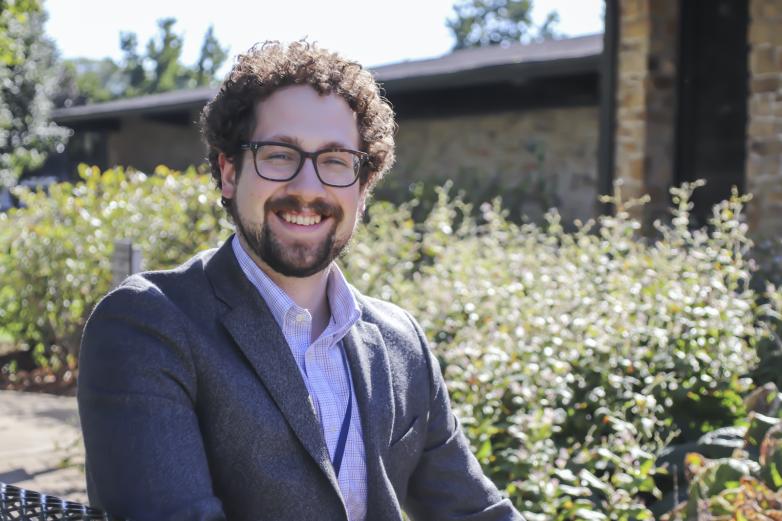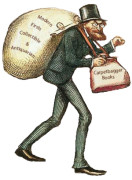Bright Young Librarians: Seth James

Our Bright Young Librarians series continues today with Seth James, Special Collections Manager at Vigo County Public Library in Terre Haute, Indiana.
What is your role at your institution?
I am the Special Collections Manager at Vigo County Public Library in Terre Haute Indiana.
How did you get started in special collections?
I first became seriously interested in Special Collections after college when I started exploring the world of book collecting. I had always collected books to an extreme degree, but my criteria for which books I would collect was purely based on whether I thought a book looked interesting. It wasn’t until I was working as an administrative assistant at a small public library that I really started investigating the world of rare books more closely. Aside from my administrative duties, I was to help sort through books that patrons had donated. One of the Friends of the Library volunteers who also sorted the donated materials was an avid book collector and he began “showing me the ropes” of identifying first edition books. Eventually this friend of mine gave me Bill McBride’s A Pocket Guide to the Identification of First Editions and from there I began digging deeper into identifying and collecting first edition works on my own. At the time I didn’t think I would be able to use this knowledge in any capacity outside of it being my hobby, but my book collector friend encouraged me to look into MLS programs with specialization tracks for Special Collections.
Where did you earn your MLS/advanced degree?
I received an MLS and an MA in history while enrolled in the dual master program at Indiana University, Bloomington. Upon arriving at IU I immediately began enrolling in all the Special Collections courses that I could. During this time I took many courses with Joel Silver while pursuing my MLS degree. Joel’s courses, as well as his willingness to endure my countless questions both in class and out, helped cultivate my growing love for Special Collections. Joel was also kind enough to be my advisor while I was at IU-Bloomington, and his patience and breadth of knowledge was an inspiration to me. I have especially fond memories of taking Joel’s Rare Book Bibliographies class which, in turn, is the cause of my obsession with bibliographies to this day.
In addition to my coursework at IU, I was also fortunate enough to work at the Lilly Library while pursuing my degrees. I first worked as a reading room attendant at the Lilly Library for several semesters, but then was given the opportunity to work as an assistant to the Head of Public Services, Rebecca Bauman. Under Rebecca’s supervision, I learned valuable skills and working knowledge that did much to prepare me for a career in Special Collections. In this job I helped staff members prepare for visiting classes, corresponded with researchers, and, probably most importantly, weekly helped to turn the page of the volume of Audubon’s The Birds of America that was displayed in the Lilly Library’s main exhibition hall. I attribute much of my success as a manager and a supervisor to Rebecca’s guidance and professional advice. I treasure my memories of working with Joel, Rebecca, and everyone else at the Lilly Library. Their enthusiasm for rare books and manuscripts, and passion for guarding and preserving these treasures inspired me then and continues to inspire me now.
Favorite rare book / ephemera that you've handled?
Although working at the Lilly Library allowed me to handle many incredible books and manuscripts, the Lilly Library’s 1543 edition of Andreas Vesalius’s De humani corporis fabrica is always at the top of my list. It was one of the first books I looked through when I started classes at Indiana University, and it was certainly one of the first that made my mouth drop open with awe. It’s a beautiful volume, with such lush and oftentimes bizarre illustrations, and a gorgeous vellum binding. There is so much to love about this book. Besides, I have a soft spot for woodcuts depicting cherubs engaging in dissections.
What do you personally collect?
For some time now I’ve been slowly collecting the Malay Edition works of Joseph Conrad. Although they are not particularly valuable, they’re beautiful books – particularly if one can find them complete with their dust covers. I’ve had limited success in finding them with their dust covers but it’s a work in progress. I also collect books on heraldry and historiography.
What do you like to do outside of work?
I love to hike, read, listen to and play music. Over the course of the COVID-19 pandemic and subsequent shutdowns my spouse and I really threw ourselves into working on my garden. Not to brag, but my tomatoes are looking pretty great this year.
What excites you about special collections librarianship?
One of my favorite aspects of my job now is showing materials from our collection to visitors. I am always happy when our visitors get excited when they see, for instance, a first edition of Their Eyes Were Watching God by Zora Neale Hurston. But I really love it when they open up the book and see Hurston’s signature and it begins to dawn on them that this isn’t just a book – it’s a piece of living, breathing history. This moment wouldn’t happen, of course, if special collections librarians weren’t advocating for the relevance of their collections and institutions in the 21st century. I am encouraged to see special collections professionals advocating for their collections all the more, and showing that special collections has a significant place in the world of academic research and in education. It is also encouraging to see more and more professors, teachers, and members of the wider public start seeing the value in special collections. In addition, I am inspired by seeing special collection institutions embrace digital exhibitions and the digitization of materials for remote access. This shows that our profession can also reach those who, for whatever reason, might not be able to visit our institutions in person. In short, I am excited by how much special collections librarians are adapting to new challenges and showing, without a doubt, that they have much more to offer the people we serve.
Thoughts on the future of special collections librarianship?
Many other people have a better grasp on what might be in store for us as special collections professionals, but, as I mentioned before, I am only seeing more enthusiasm and interest from the public in what we do. I think that in our digitally saturated age, people often do yearn for the comfort of the physical object. That isn’t to say that the digital age hasn’t helped us in significant ways; social media has been an excellent tool for promoting our collections, and our digitized collections have been essential for researchers (especially during COVID-19).
I also believe that public libraries have a significant part to play in the future of special collections. I think it’s essential that special collections institutions show that their collections are relevant outside of the academic context, and public libraries are well-suited to do that. Our institutions preserve these materials for the education, enjoyment, and benefit of all, and I am proud of the unique role that public libraries can play in doing this.
All of which is to say, I think the future for special collections is bright, and I’m honored to be a part of that future.
Any unusual or interesting collection at your library you'd like to draw our attention to?
I am particularly proud of our collection of inscribed Zora Neale Hurston first editions, which are in beautiful condition. We also have a two volume set of Ovid’s Metamorphoses, in Latin and English, from 1724. We also have a 1669 edition of Ogilby’s Homer, which has been a big hit with our visiting classes from Indiana State University. We have many more rare books and manuscript collections worth of note, and I’m very glad that our library can be their home.
Any upcoming exhibitions at your library?
We are currently preparing an exhibition in honor of the 100th anniversary of the passage of the 19th amendment. We will be drawing from our collections to highlight several important figures and organizations that were involved in the Women’s Suffrage movement in Indiana, including activist, author, and Terre Haute resident Ida Husted Harper.
















